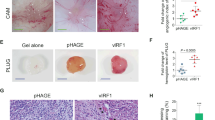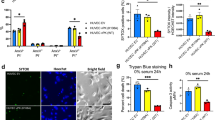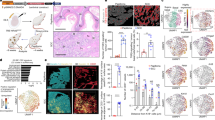Abstract
Kaposi sarcoma (KS), a multifocal neoplasm of the skin that can spread to visceral organs, is the most prevalent malignant tumor in acquired immuno deficiency syndrome (AIDS) patients. KS-associated herpesvirus (KSHV or HHV8) is considered the primary etiological factor of this malignancy, as well as of primary effusion lymphoma and multicentric Castleman's disease. KS lesions are characterized by proliferating spindle cells of endothelial cell (EC) origin. The action of the insulin-like growth factor (IGF) system has been implicated in many malignancies, and recent data have demonstrated that the IGF-I receptor (IGF-IR) is required for in vitro growth of the KS-derived KSIMM cell line. To examine whether the IGF pathway is also involved in KSHV-mediated transformation of ECs, we examined the expression and function of the IGF system in KSHV-infected, immortalized dermal microvascular EC (E-DMVEC). The expression of the insulin receptor (IR) was strongly induced in latently infected E-DMVEC, whereas the expression levels of the IGF-IR remained unchanged. Gene knockdown of IR, but not IGF-IR, prevented the characteristic focus formation seen in KSHV-infected E-DMVEC. Similarly, treatment with the IR-specific small-molecule inhibitor HNMPA-(AM3) inhibited postconfluent growth. These data suggest a role for the IR, but not the IGF-IR, in KSHV-induced transformation of vascular ECs.
This is a preview of subscription content, access via your institution
Access options
Subscribe to this journal
Receive 50 print issues and online access
$259.00 per year
only $5.18 per issue
Buy this article
- Purchase on Springer Link
- Instant access to full article PDF
Prices may be subject to local taxes which are calculated during checkout







Similar content being viewed by others
References
Albini A, Paglieri I, Orengo G, Carlone S, Aluigi MG, DeMarchi R et al. (1997). The beta-core fragment of human chorionic gonadotrophin inhibits growth of Kaposi's sarcoma-derived cells and a new immortalized Kaposi's sarcoma cell line. Aids 11: 713–721.
Baltensperger K, Lewis RE, Woon CW, Vissavajjhala P, Ross AH, Czech MP . (1992). Catalysis of serine and tyrosine autophosphorylation by the human insulin receptor. Proc Natl Acad Sci USA 89: 7885–7889.
Boshoff C, Schulz TF, Kennedy MM, Graham AK, Fisher C, Thomas A et al. (1995). Kaposi's sarcoma-associated herpesvirus infects endothelial and spindle cells. Nat Med 1: 1274–1278.
Catrina SB, Lewitt M, Massambu C, Dricu A, Grunler J, Axelson M et al. (2005). Insulin-like growth factor-I receptor is essential for Kaposi's sarcoma growth and survival. Br J Cancer 92: 1467–1474.
Ciufo DM, Cannon JS, Poole LJ, Wu FY, Murray P, Ambinder RF et al. (2001). Spindle cell conversion by Kaposi's sarcoma-associated herpesvirus: formation of colonies and plaques with mixed lytic and latent gene expression in infected primary dermal microvascular endothelial cell cultures. J Virol 75: 5614–5626.
Denley A, Bonython ER, Booker GW, Cosgrove LJ, Forbes BE, Ward CW et al. (2004). Structural determinants for high-affinity binding of insulin-like growth factor II to insulin receptor (IR)-A, the exon 11 minus isoform of the IR. Mol Endocrinol 18: 2502–2512.
Denley A, Wallace JC, Cosgrove LJ, Forbes BE . (2003). The insulin receptor isoform exon 11-(IR-A) in cancer and other diseases: a review. Horm Metab Res 35: 778–785.
Flamand L, Zeman RA, Bryant JL, Lunardi-Iskandar Y, Gallo RC . (1996). Absence of human herpesvirus 8 DNA sequences in neoplastic Kaposi's sarcoma cell lines. J Acquir Immune Defic Syndr Hum Retrovirol 13: 194–197.
Grundhoff A, Ganem D . (2004). Inefficient establishment of KSHV latency suggests an additional role for continued lytic replication in Kaposi sarcoma pathogenesis. J Clin Invest 113: 124–136.
Hailey J, Maxwell E, Koukouras K, Bishop WR, Pachter JA, Wang Y . (2002). Neutralizing anti-insulin-like growth factor receptor antibodies inhibit receptor function and induce receptor degradation in tumor cells. Mol Cancer Ther 1: 1349–1353.
Jenner RG, Boshoff C . (2002). The molecular pathology of Kaposi's sarcoma-associated herpesvirus. Biochim Biophys Acta 1602: 1–22.
Lagunoff M, Bechtel J, Venetsanakos E, Roy AM, Abbey N, Herndier B et al. (2002). De novo infection and serial transmission of Kaposi's sarcoma-associated herpesvirus in cultured endothelial cells. J Virol 76: 2440–2448.
Leibiger B, Leibiger IB, Moede T, Kemper S, Kulkarni RN, Kahn CR et al. (2001). Selective insulin signaling through A and B insulin receptors regulates transcription of insulin and glucokinase genes in pancreatic beta cells. Mol Cell 7: 559–570.
LeRoith D, Roberts Jr CT . (2003). The insulin-like growth factor system and cancer. Cancer Lett 195: 127–137.
Livak KJ, Schmittgen TD . (2001). Analysis of relative gene expression data using real-time quantitative PCR and the 2(-Delta Delta C(T)) method. Methods 25: 402–408.
Lunardi-Iskandar Y, Gill P, Lam VH, Zeman RA, Michaels F, Mann DL et al. (1995). Isolation and characterization of an immortal neoplastic cell line (KS Y-1) from AIDS-associated Kaposi's sarcoma. J Natl Cancer Inst 87: 974–981.
McAllister SC, Hansen SG, Ruhl RA, Raggo CM, DeFilippis VR, Greenspan D et al. (2004). Kaposi sarcoma-associated herpesvirus (KSHV) induces heme oxygenase-1 expression and activity in KSHV-infected endothelial cells. Blood 103: 3465–3473.
Moses AV, Fish KN, Ruhl R, Smith PP, Strussenberg JG, Zhu L et al. (1999). Long-term infection and transformation of dermal microvascular endothelial cells by human herpesvirus 8. J Virol 73: 6892–6902.
Moses AV, Jarvis MA, Raggo C, Bell YC, Ruhl R, Luukkonen BG et al. (2002). Kaposi's sarcoma-associated herpesvirus-induced upregulation of the c-kit proto-oncogene, as identified by gene expression profiling, is essential for the transformation of endothelial cells. J Virol 76: 8383–8399.
Orem J, Otieno MW, Remick SC . (2004). AIDS-associated cancer in developing nations. Curr Opin Oncol 16: 468–476.
Ottensmeyer FP, Beniac DR, Luo RZ, Yip CC . (2000). Mechanism of transmembrane signaling: insulin binding and the insulin receptor. Biochemistry 39: 12103–12112.
Parravicini C, Chandran B, Corbellino M, Berti E, Paulli M, Moore PS et al. (2000). Differential viral protein expression in Kaposi's sarcoma-associated herpesvirus-infected diseases: Kaposi's sarcoma, primary effusion lymphoma, and multicentric Castleman's disease. Am J Pathol 156: 743–749.
Raggo C, Ruhl R, McAllister S, Koon H, Dezube BJ, Fruh K et al. (2005). Novel cellular genes essential for transformation of endothelial cells by Kaposi's sarcoma-associated herpesvirus. Cancer Res 65: 5084–5095.
Saperstein R, Vicario PP, Strout HV, Brady E, Slater EE, Greenlee WJ et al. (1989). Design of a selective insulin receptor tyrosine kinase inhibitor and its effect on glucose uptake and metabolism in intact cells. Biochemistry 28: 5694–5701.
Sciacca L, Costantino A, Pandini G, Mineo R, Frasca F, Scalia P et al. (1999). Insulin receptor activation by IGF-II in breast cancers: evidence for a new autocrine/paracrine mechanism. Oncogene 18: 2471–2479.
Sciacca L, Mineo R, Pandini G, Murabito A, Vigneri R, Belfiore A . (2002). In IGF-I receptor-deficient leiomyosarcoma cells autocrine IGF-II induces cell invasion and protection from apoptosis via the insulin receptor isoform A. Oncogene 21: 8240–8250.
Sharma-Walia N, Krishnan HH, Naranatt PP, Zeng L, Smith MS, Chandran B . (2005). ERK1/2 and MEK 1/2 induced by Kaposi's sarcoma-associated herpesvirus (human herpesvirus 8) early during infection of target cells are essential for expression of viral genes and for establishment of infection. J Virol 79: 10308–10329.
Staskus KA, Zhong W, Gebhard K, Herndier B, Wang H, Renne R et al. (1997). Kaposi's sarcoma-associated herpesvirus gene expression in endothelial (spindle) tumor cells. J Virol 71: 715–719.
Surmacz E . (2003). Growth factor receptors as therapeutic targets: strategies to inhibit the insulin-like growth factor I receptor. Oncogene 22: 6589–6597.
Virkamaki A, Ueki K, Kahn CR . (1999). Protein-protein interaction in insulin signaling and the molecular mechanisms of insulin resistance. J Clin Invest 103: 931–943.
Wang HW, Trotter MW, Lagos D, Bourboulia D, Henderson S, Makinen T et al. (2004). Kaposi sarcoma herpesvirus-induced cellular programming contributes to the lymphatic endothelial gene expression in Kaposi sarcoma. Nat Genet 36: 687–693.
Acknowledgements
This work was supported by Grants PS1-RR00163 and RO1-CA099906 (AVM and KF). Initial support for this project was from Virogenomics, Inc., a company that may have a commercial interest in the results of this research. A potential conflict of interest by KF and AVM has been reviewed and managed by the OHSU Conflict of Interest in Research Committee. PPR was supported by the Molecular Hematology Training Grant T32 HL007781-13 and a Tartar Trust fellowship. This work was also partially supported by an award from the American Heart Association to PPR.
Author information
Authors and Affiliations
Corresponding author
Additional information
Supplementary Information accompanies the paper on the Oncogene website (http://www.nature.com/onc).
Supplementary information
Rights and permissions
About this article
Cite this article
Rose, P., Carroll, J., Carroll, P. et al. The insulin receptor is essential for virus-induced tumorigenesis of Kaposi's sarcoma. Oncogene 26, 1995–2005 (2007). https://doi.org/10.1038/sj.onc.1210006
Received:
Revised:
Accepted:
Published:
Issue Date:
DOI: https://doi.org/10.1038/sj.onc.1210006
Keywords
This article is cited by
-
Obesity and cancer, a case for insulin signaling
Cell Death & Disease (2015)
-
Insulin and IGFs in Obesity-Related Breast Cancer
Journal of Mammary Gland Biology and Neoplasia (2013)
-
Insulin receptor signaling activated by penta-O-galloyl-α-d-glucopyranose induces p53 and apoptosis in cancer cells
Apoptosis (2011)
-
Physical and functional interaction between polyoma virus middle T antigen and insulin and IGF-I receptors is required for oncogene activation and tumour initiation
Oncogene (2009)



